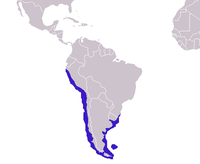South American sea lion
| South American sea lion | |
|---|---|
 |
|
| Male and female | |
| Scientific classification | |
| Kingdom: | Animalia |
| Phylum: | Chordata |
| Class: | Mammalia |
| Order: | Carnivora |
| Suborder: | Pinnipedia |
| Family: | Otariidae |
| Subfamily: | Otariinae |
| Genus: |
Otaria Péron, 1816 |
| Species: | O. flavescens |
| Binomial name | |
|
Otaria flavescens (Shaw, 1800) |
|
 |
|
| South American sea lion range | |
| Synonyms | |
|
Otaria byronia |
|
Otaria byronia
The South American sea lion (Otaria flavescens, formerly Otaria byronia), also called the southern sea lion and the Patagonian sea lion, is a sea lion found on the Chilean, Ecuador, Peruvian, Uruguayan, Argentine and Southern Brazilian coasts. It is the only member of the genus Otaria. Its scientific name was subject to controversy, with some taxonomists referring to it as Otaria flavescens and others referring to it as Otaria byronia. The former eventually won out, although that may still be overturned. Locally, it is known by several names, most commonly lobo marino (es)/lobo marinho (pt) (sea wolf) and león marino (es)/leão marinho (pt) (sea lion).
The South American sea lion is perhaps the archetypal sea lion in appearance. Males have a very large head with a well-developed mane, making them the most lionesque of the eared seals. They are twice the weight of females. Both males and females are orange or brown coloured with upturned snouts. Pups are born greyish orange ventrally and black dorsally and moult into a more chocolate colour.
The South American sea lion's size and weight can vary considerably. Adult males can grow over 2.73 m (9 ft) and weigh up to 350 kg (770 lb). Adult females grow up to 1.8–2 m (6–7 ft) and weigh about half the weight of the males, around 150 kg (330 lb). This species is even more sexually dimorphic than the other sea lions.
The South American sea lion is found along the coasts and offshore islands of South America, from Peru south to Chile in the Pacific and then north to southern Brazil in the Atlantic. It travels north during the winter and spring and goes south to breed. Notable breeding colonies include Lobos Island, Uruguay; Peninsula Valdes, Argentina; Beagle Channel, and the Falkland Islands. Some individuals wander as far north as southern Ecuador, although apparently they never bred there.
...
Wikipedia

